Integrating Practice 1: Blood Pressure Measurement Reflection
VerifiedAdded on 2022/09/25
|6
|1492
|16
Report
AI Summary
This report presents a student's reflection on the process of blood pressure measurement, framed within the Gibbs Reflective Cycle. The student describes the steps involved in the procedure, drawing from a video observation, including equipment assembly, patient preparation, and the actual measurement process. The student reflects on their feelings during the observation, noting both the nurse's competence and their own anxieties about performing the procedure. An evaluation of the nurse's actions highlights the use of appropriate tools, holistic assessment, and effective communication. The student critically analyzes the nurse's approach, focusing on professional responsibility, communication skills and the use of medical jargon. The reflection includes areas for improvement, such as patient introduction and non-verbal communication. Finally, an action plan outlines how the student would approach the situation, emphasizing informed consent and patient comfort. The assignment aligns with the NRSG139 course objectives, particularly the assessment of physical health and reflective practice. The student effectively integrates theoretical knowledge with practical observation to enhance their clinical skills.
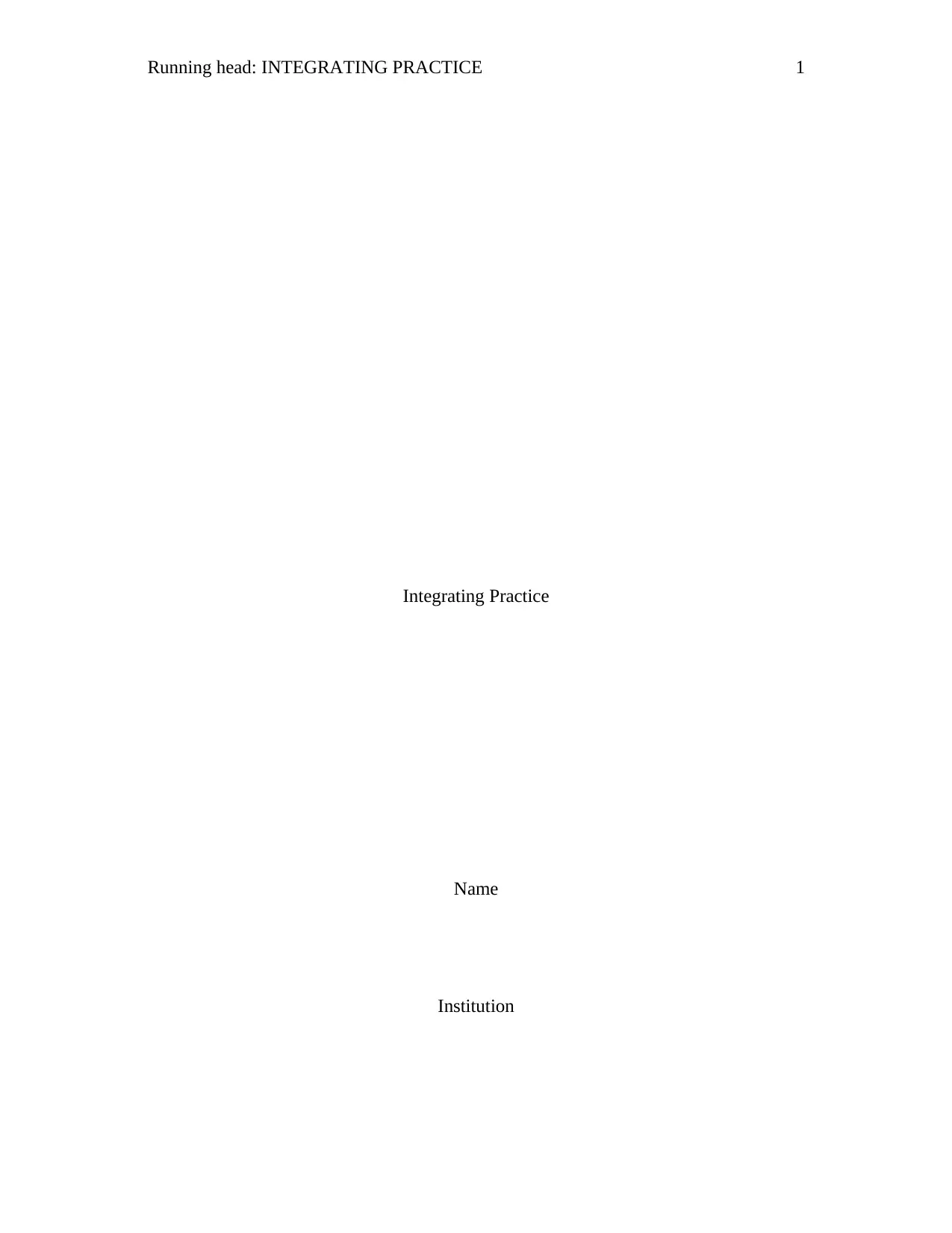
Running head: INTEGRATING PRACTICE 1
Integrating Practice
Name
Institution
Integrating Practice
Name
Institution
Paraphrase This Document
Need a fresh take? Get an instant paraphrase of this document with our AI Paraphraser
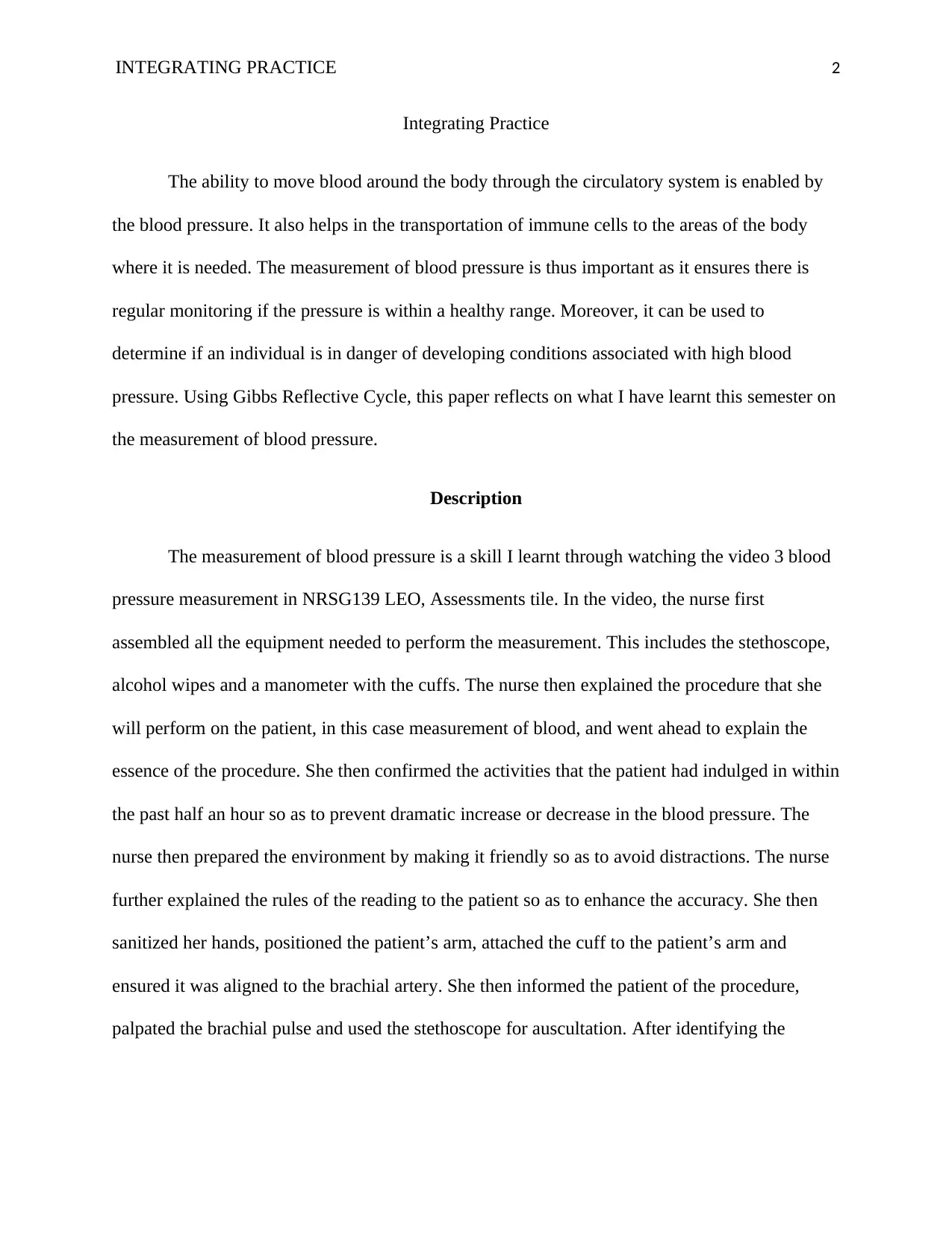
INTEGRATING PRACTICE 2
Integrating Practice
The ability to move blood around the body through the circulatory system is enabled by
the blood pressure. It also helps in the transportation of immune cells to the areas of the body
where it is needed. The measurement of blood pressure is thus important as it ensures there is
regular monitoring if the pressure is within a healthy range. Moreover, it can be used to
determine if an individual is in danger of developing conditions associated with high blood
pressure. Using Gibbs Reflective Cycle, this paper reflects on what I have learnt this semester on
the measurement of blood pressure.
Description
The measurement of blood pressure is a skill I learnt through watching the video 3 blood
pressure measurement in NRSG139 LEO, Assessments tile. In the video, the nurse first
assembled all the equipment needed to perform the measurement. This includes the stethoscope,
alcohol wipes and a manometer with the cuffs. The nurse then explained the procedure that she
will perform on the patient, in this case measurement of blood, and went ahead to explain the
essence of the procedure. She then confirmed the activities that the patient had indulged in within
the past half an hour so as to prevent dramatic increase or decrease in the blood pressure. The
nurse then prepared the environment by making it friendly so as to avoid distractions. The nurse
further explained the rules of the reading to the patient so as to enhance the accuracy. She then
sanitized her hands, positioned the patient’s arm, attached the cuff to the patient’s arm and
ensured it was aligned to the brachial artery. She then informed the patient of the procedure,
palpated the brachial pulse and used the stethoscope for auscultation. After identifying the
Integrating Practice
The ability to move blood around the body through the circulatory system is enabled by
the blood pressure. It also helps in the transportation of immune cells to the areas of the body
where it is needed. The measurement of blood pressure is thus important as it ensures there is
regular monitoring if the pressure is within a healthy range. Moreover, it can be used to
determine if an individual is in danger of developing conditions associated with high blood
pressure. Using Gibbs Reflective Cycle, this paper reflects on what I have learnt this semester on
the measurement of blood pressure.
Description
The measurement of blood pressure is a skill I learnt through watching the video 3 blood
pressure measurement in NRSG139 LEO, Assessments tile. In the video, the nurse first
assembled all the equipment needed to perform the measurement. This includes the stethoscope,
alcohol wipes and a manometer with the cuffs. The nurse then explained the procedure that she
will perform on the patient, in this case measurement of blood, and went ahead to explain the
essence of the procedure. She then confirmed the activities that the patient had indulged in within
the past half an hour so as to prevent dramatic increase or decrease in the blood pressure. The
nurse then prepared the environment by making it friendly so as to avoid distractions. The nurse
further explained the rules of the reading to the patient so as to enhance the accuracy. She then
sanitized her hands, positioned the patient’s arm, attached the cuff to the patient’s arm and
ensured it was aligned to the brachial artery. She then informed the patient of the procedure,
palpated the brachial pulse and used the stethoscope for auscultation. After identifying the
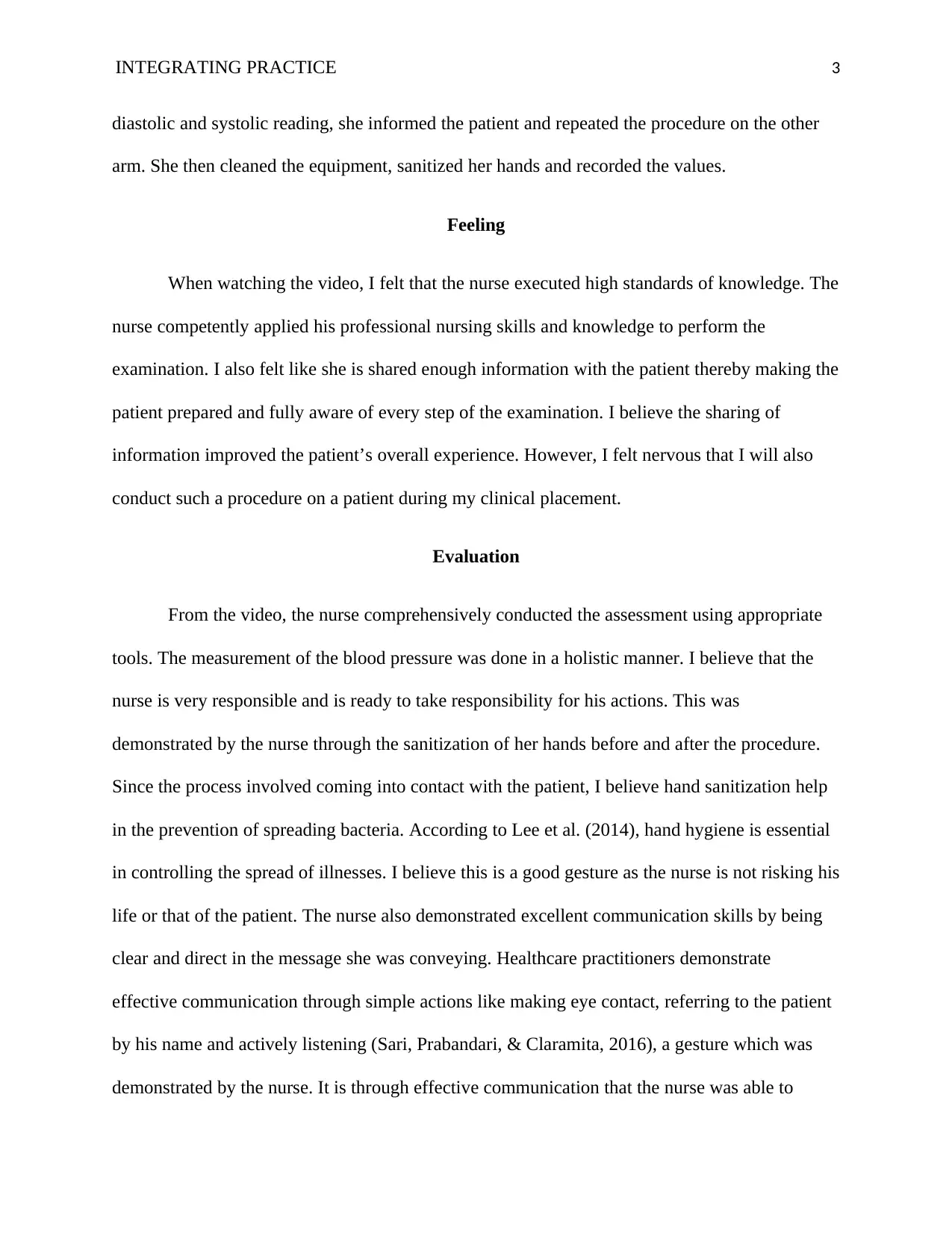
INTEGRATING PRACTICE 3
diastolic and systolic reading, she informed the patient and repeated the procedure on the other
arm. She then cleaned the equipment, sanitized her hands and recorded the values.
Feeling
When watching the video, I felt that the nurse executed high standards of knowledge. The
nurse competently applied his professional nursing skills and knowledge to perform the
examination. I also felt like she is shared enough information with the patient thereby making the
patient prepared and fully aware of every step of the examination. I believe the sharing of
information improved the patient’s overall experience. However, I felt nervous that I will also
conduct such a procedure on a patient during my clinical placement.
Evaluation
From the video, the nurse comprehensively conducted the assessment using appropriate
tools. The measurement of the blood pressure was done in a holistic manner. I believe that the
nurse is very responsible and is ready to take responsibility for his actions. This was
demonstrated by the nurse through the sanitization of her hands before and after the procedure.
Since the process involved coming into contact with the patient, I believe hand sanitization help
in the prevention of spreading bacteria. According to Lee et al. (2014), hand hygiene is essential
in controlling the spread of illnesses. I believe this is a good gesture as the nurse is not risking his
life or that of the patient. The nurse also demonstrated excellent communication skills by being
clear and direct in the message she was conveying. Healthcare practitioners demonstrate
effective communication through simple actions like making eye contact, referring to the patient
by his name and actively listening (Sari, Prabandari, & Claramita, 2016), a gesture which was
demonstrated by the nurse. It is through effective communication that the nurse was able to
diastolic and systolic reading, she informed the patient and repeated the procedure on the other
arm. She then cleaned the equipment, sanitized her hands and recorded the values.
Feeling
When watching the video, I felt that the nurse executed high standards of knowledge. The
nurse competently applied his professional nursing skills and knowledge to perform the
examination. I also felt like she is shared enough information with the patient thereby making the
patient prepared and fully aware of every step of the examination. I believe the sharing of
information improved the patient’s overall experience. However, I felt nervous that I will also
conduct such a procedure on a patient during my clinical placement.
Evaluation
From the video, the nurse comprehensively conducted the assessment using appropriate
tools. The measurement of the blood pressure was done in a holistic manner. I believe that the
nurse is very responsible and is ready to take responsibility for his actions. This was
demonstrated by the nurse through the sanitization of her hands before and after the procedure.
Since the process involved coming into contact with the patient, I believe hand sanitization help
in the prevention of spreading bacteria. According to Lee et al. (2014), hand hygiene is essential
in controlling the spread of illnesses. I believe this is a good gesture as the nurse is not risking his
life or that of the patient. The nurse also demonstrated excellent communication skills by being
clear and direct in the message she was conveying. Healthcare practitioners demonstrate
effective communication through simple actions like making eye contact, referring to the patient
by his name and actively listening (Sari, Prabandari, & Claramita, 2016), a gesture which was
demonstrated by the nurse. It is through effective communication that the nurse was able to
⊘ This is a preview!⊘
Do you want full access?
Subscribe today to unlock all pages.

Trusted by 1+ million students worldwide
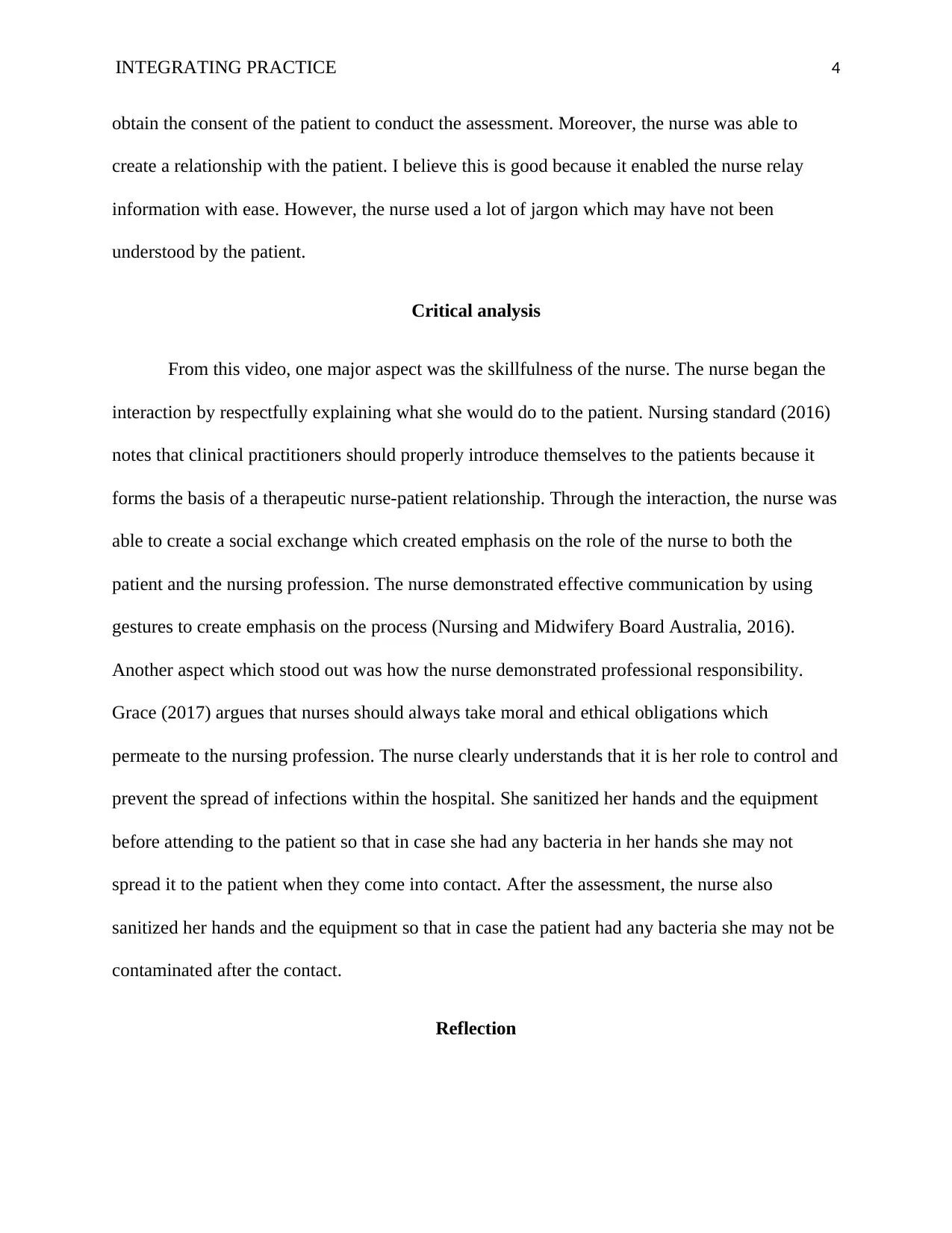
INTEGRATING PRACTICE 4
obtain the consent of the patient to conduct the assessment. Moreover, the nurse was able to
create a relationship with the patient. I believe this is good because it enabled the nurse relay
information with ease. However, the nurse used a lot of jargon which may have not been
understood by the patient.
Critical analysis
From this video, one major aspect was the skillfulness of the nurse. The nurse began the
interaction by respectfully explaining what she would do to the patient. Nursing standard (2016)
notes that clinical practitioners should properly introduce themselves to the patients because it
forms the basis of a therapeutic nurse-patient relationship. Through the interaction, the nurse was
able to create a social exchange which created emphasis on the role of the nurse to both the
patient and the nursing profession. The nurse demonstrated effective communication by using
gestures to create emphasis on the process (Nursing and Midwifery Board Australia, 2016).
Another aspect which stood out was how the nurse demonstrated professional responsibility.
Grace (2017) argues that nurses should always take moral and ethical obligations which
permeate to the nursing profession. The nurse clearly understands that it is her role to control and
prevent the spread of infections within the hospital. She sanitized her hands and the equipment
before attending to the patient so that in case she had any bacteria in her hands she may not
spread it to the patient when they come into contact. After the assessment, the nurse also
sanitized her hands and the equipment so that in case the patient had any bacteria she may not be
contaminated after the contact.
Reflection
obtain the consent of the patient to conduct the assessment. Moreover, the nurse was able to
create a relationship with the patient. I believe this is good because it enabled the nurse relay
information with ease. However, the nurse used a lot of jargon which may have not been
understood by the patient.
Critical analysis
From this video, one major aspect was the skillfulness of the nurse. The nurse began the
interaction by respectfully explaining what she would do to the patient. Nursing standard (2016)
notes that clinical practitioners should properly introduce themselves to the patients because it
forms the basis of a therapeutic nurse-patient relationship. Through the interaction, the nurse was
able to create a social exchange which created emphasis on the role of the nurse to both the
patient and the nursing profession. The nurse demonstrated effective communication by using
gestures to create emphasis on the process (Nursing and Midwifery Board Australia, 2016).
Another aspect which stood out was how the nurse demonstrated professional responsibility.
Grace (2017) argues that nurses should always take moral and ethical obligations which
permeate to the nursing profession. The nurse clearly understands that it is her role to control and
prevent the spread of infections within the hospital. She sanitized her hands and the equipment
before attending to the patient so that in case she had any bacteria in her hands she may not
spread it to the patient when they come into contact. After the assessment, the nurse also
sanitized her hands and the equipment so that in case the patient had any bacteria she may not be
contaminated after the contact.
Reflection
Paraphrase This Document
Need a fresh take? Get an instant paraphrase of this document with our AI Paraphraser
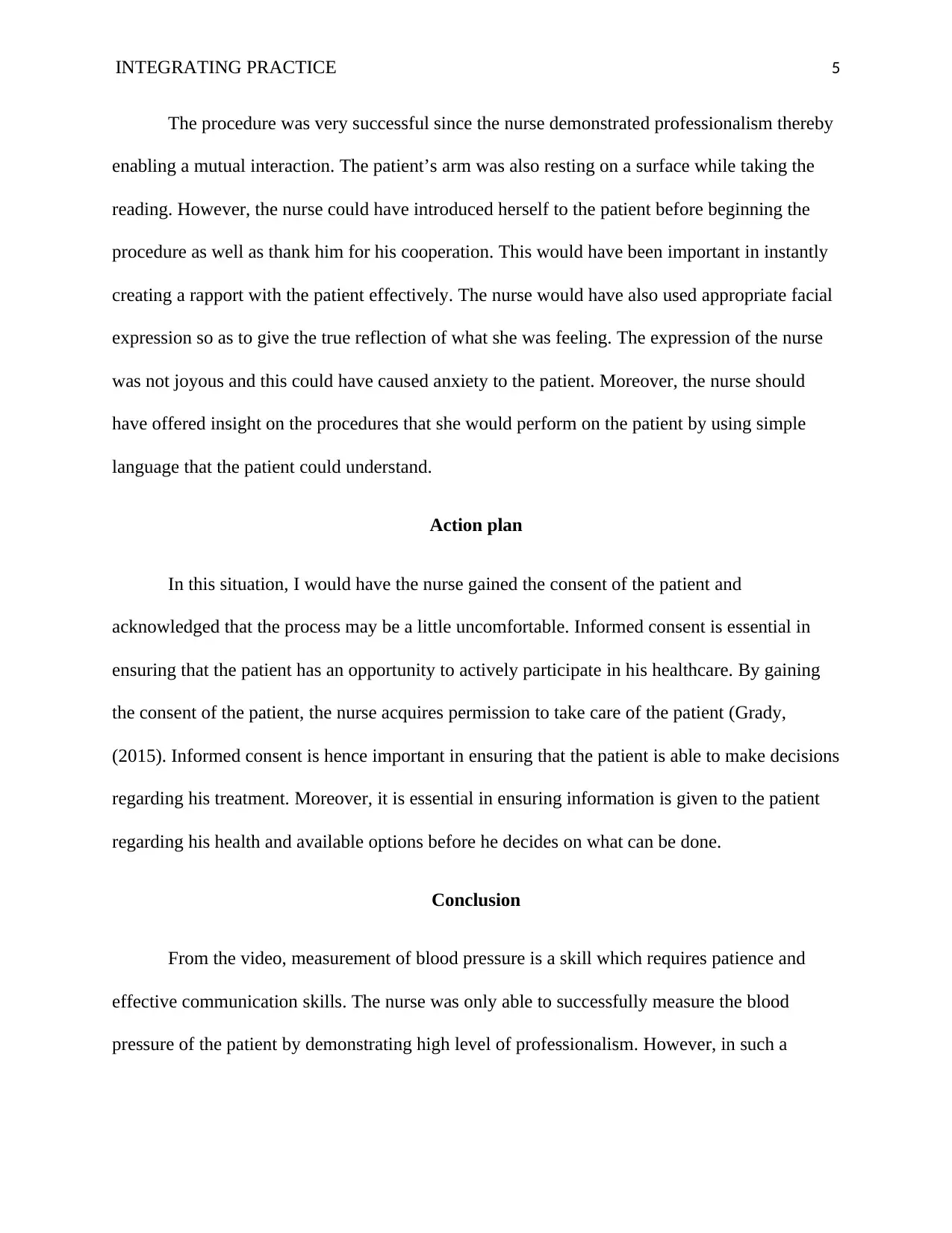
INTEGRATING PRACTICE 5
The procedure was very successful since the nurse demonstrated professionalism thereby
enabling a mutual interaction. The patient’s arm was also resting on a surface while taking the
reading. However, the nurse could have introduced herself to the patient before beginning the
procedure as well as thank him for his cooperation. This would have been important in instantly
creating a rapport with the patient effectively. The nurse would have also used appropriate facial
expression so as to give the true reflection of what she was feeling. The expression of the nurse
was not joyous and this could have caused anxiety to the patient. Moreover, the nurse should
have offered insight on the procedures that she would perform on the patient by using simple
language that the patient could understand.
Action plan
In this situation, I would have the nurse gained the consent of the patient and
acknowledged that the process may be a little uncomfortable. Informed consent is essential in
ensuring that the patient has an opportunity to actively participate in his healthcare. By gaining
the consent of the patient, the nurse acquires permission to take care of the patient (Grady,
(2015). Informed consent is hence important in ensuring that the patient is able to make decisions
regarding his treatment. Moreover, it is essential in ensuring information is given to the patient
regarding his health and available options before he decides on what can be done.
Conclusion
From the video, measurement of blood pressure is a skill which requires patience and
effective communication skills. The nurse was only able to successfully measure the blood
pressure of the patient by demonstrating high level of professionalism. However, in such a
The procedure was very successful since the nurse demonstrated professionalism thereby
enabling a mutual interaction. The patient’s arm was also resting on a surface while taking the
reading. However, the nurse could have introduced herself to the patient before beginning the
procedure as well as thank him for his cooperation. This would have been important in instantly
creating a rapport with the patient effectively. The nurse would have also used appropriate facial
expression so as to give the true reflection of what she was feeling. The expression of the nurse
was not joyous and this could have caused anxiety to the patient. Moreover, the nurse should
have offered insight on the procedures that she would perform on the patient by using simple
language that the patient could understand.
Action plan
In this situation, I would have the nurse gained the consent of the patient and
acknowledged that the process may be a little uncomfortable. Informed consent is essential in
ensuring that the patient has an opportunity to actively participate in his healthcare. By gaining
the consent of the patient, the nurse acquires permission to take care of the patient (Grady,
(2015). Informed consent is hence important in ensuring that the patient is able to make decisions
regarding his treatment. Moreover, it is essential in ensuring information is given to the patient
regarding his health and available options before he decides on what can be done.
Conclusion
From the video, measurement of blood pressure is a skill which requires patience and
effective communication skills. The nurse was only able to successfully measure the blood
pressure of the patient by demonstrating high level of professionalism. However, in such a
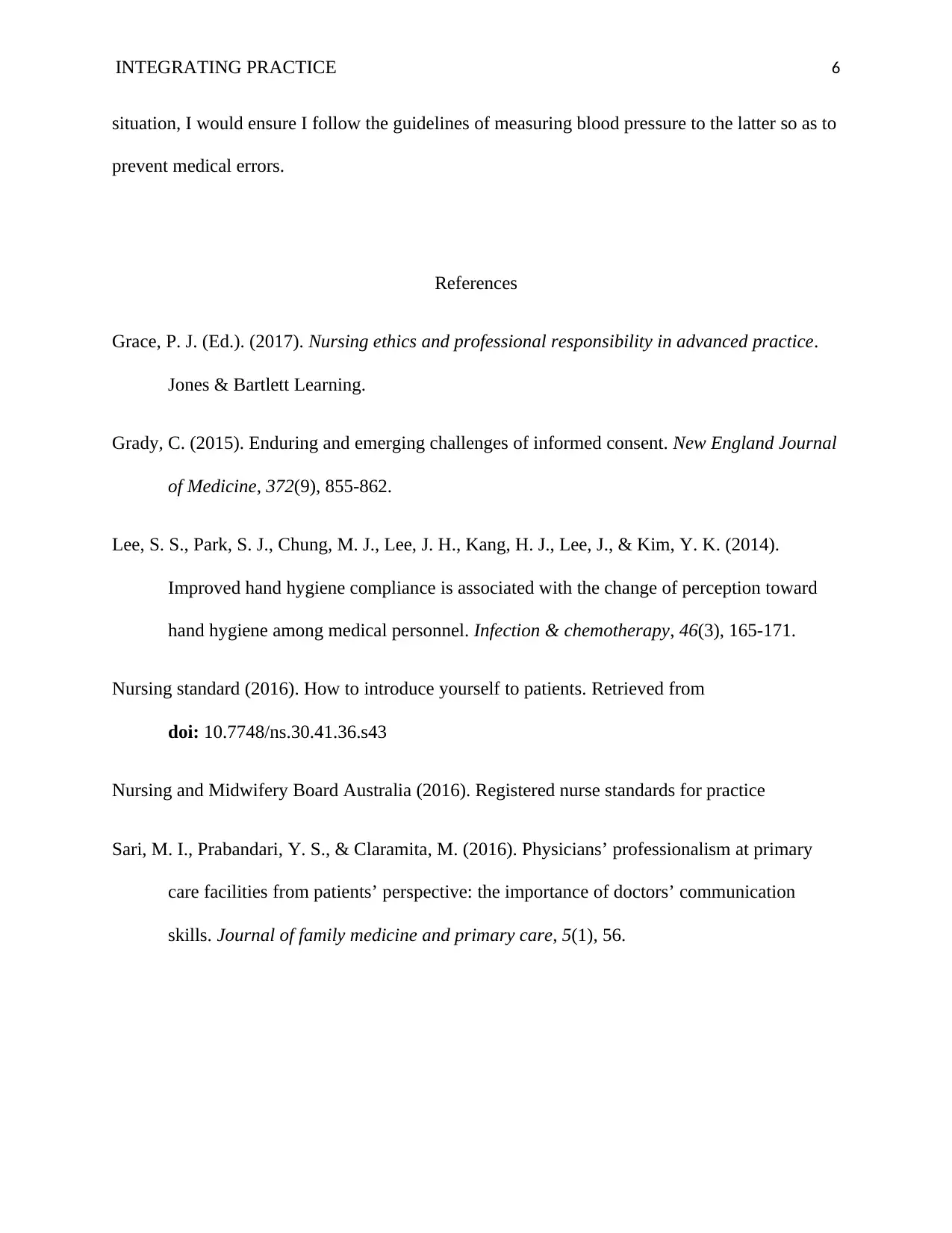
INTEGRATING PRACTICE 6
situation, I would ensure I follow the guidelines of measuring blood pressure to the latter so as to
prevent medical errors.
References
Grace, P. J. (Ed.). (2017). Nursing ethics and professional responsibility in advanced practice.
Jones & Bartlett Learning.
Grady, C. (2015). Enduring and emerging challenges of informed consent. New England Journal
of Medicine, 372(9), 855-862.
Lee, S. S., Park, S. J., Chung, M. J., Lee, J. H., Kang, H. J., Lee, J., & Kim, Y. K. (2014).
Improved hand hygiene compliance is associated with the change of perception toward
hand hygiene among medical personnel. Infection & chemotherapy, 46(3), 165-171.
Nursing standard (2016). How to introduce yourself to patients. Retrieved from
doi: 10.7748/ns.30.41.36.s43
Nursing and Midwifery Board Australia (2016). Registered nurse standards for practice
Sari, M. I., Prabandari, Y. S., & Claramita, M. (2016). Physicians’ professionalism at primary
care facilities from patients’ perspective: the importance of doctors’ communication
skills. Journal of family medicine and primary care, 5(1), 56.
situation, I would ensure I follow the guidelines of measuring blood pressure to the latter so as to
prevent medical errors.
References
Grace, P. J. (Ed.). (2017). Nursing ethics and professional responsibility in advanced practice.
Jones & Bartlett Learning.
Grady, C. (2015). Enduring and emerging challenges of informed consent. New England Journal
of Medicine, 372(9), 855-862.
Lee, S. S., Park, S. J., Chung, M. J., Lee, J. H., Kang, H. J., Lee, J., & Kim, Y. K. (2014).
Improved hand hygiene compliance is associated with the change of perception toward
hand hygiene among medical personnel. Infection & chemotherapy, 46(3), 165-171.
Nursing standard (2016). How to introduce yourself to patients. Retrieved from
doi: 10.7748/ns.30.41.36.s43
Nursing and Midwifery Board Australia (2016). Registered nurse standards for practice
Sari, M. I., Prabandari, Y. S., & Claramita, M. (2016). Physicians’ professionalism at primary
care facilities from patients’ perspective: the importance of doctors’ communication
skills. Journal of family medicine and primary care, 5(1), 56.
⊘ This is a preview!⊘
Do you want full access?
Subscribe today to unlock all pages.

Trusted by 1+ million students worldwide
1 out of 6
Related Documents
Your All-in-One AI-Powered Toolkit for Academic Success.
+13062052269
info@desklib.com
Available 24*7 on WhatsApp / Email
![[object Object]](/_next/static/media/star-bottom.7253800d.svg)
Unlock your academic potential
Copyright © 2020–2025 A2Z Services. All Rights Reserved. Developed and managed by ZUCOL.





